The Acer Predator Triton 500 Laptop Review: Going Thin with GeForce RTX 2080
by Brett Howse on April 25, 2019 8:00 AM ESTWireless
For networking, Acer has turned to Killer Networking for both the Gigabit Ethernet, as well as the wireless adapter. The Acer Predator Triton 500 features the Killer Wireless-AC 1550, which is based on Intel’s excellent 9260 Wi-Fi solution, and the Killer E3000 Ethernet adapter. The big change over Intel’s previous 826x wireless is that the 9260 card offers support for 160 Mhz channels, meaning there is a peak theoretical speed of 1.73 Gbps with the 2x2:2 offering, but you’ll need a new access point with wide channel support to get this. In fact, we don’t even have an access point yet with this kind of capability, and even if you did, it runs into issues with what else is connected – most Ethernet is still going to be maxed out at Gigabit.
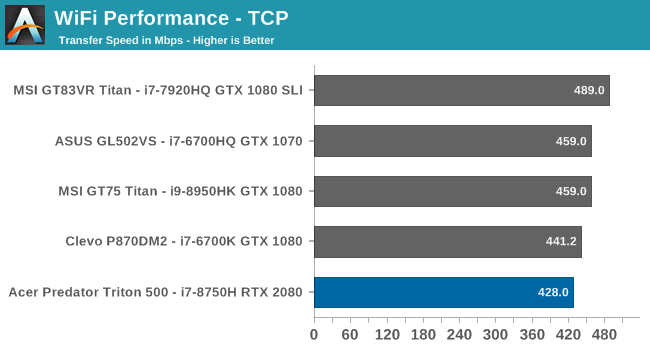
Performance on the 80 Mhz channels was only average, but if you do need more than the wireless offers, the wired Ethernet is available, or you can combine both with Killer’s DoubleShot Pro software, which can send some traffic over the slower connection to keep your lowest latency network free for gaming. It’s not likely something that is necessary most of the time, but it’s available if needed.
The main advantage of the Killer 1550 though is that being based on Intel’s rock solid wireless networking solution, Killer also gets the benefit of very stable drivers. Over the last couple of years, Intel has walked away with the wireless market, offering the fastest, and most stable networking around. Killer made a wise move partnering with Intel for their latest wireless products.
Audio
Acer offers Waves MaxxAudio for software defined equalization, and it also includes Waves Nx for positional audio, for faux 3-D. The software offers a full graphic EQ as well as some acoustic adjustments to change the bass response, detail, and sound stage width. The speakers actually sound decent considering how thin the laptop is, and there is excellent stereo separation. Bass response is much better than many laptops, and the overall volume level can go up to about 80 dB(A) measured one inch over the trackpad.
For headphones, Acer offers separate 3.5 mm headphone and microphone jacks, and when using headphones the Waves Nx is available for 3D positional audio. The amount of effect can be adjusted in the software, and while it does make 2D audio seem wider than 3D, it can also be disabled if you prefer a more natural sound.
Thermals
The biggest challenge for any gaming laptop is how to deal with the massive amounts of heat generated by modern CPUs and GPUs when gaming, and that is doubly true on thin and light models such as the Acer Predator Triton 500. Acer has approached the problem with some smart engineering and some brute force.
The Triton 500 leverages three fans based on fourth generation AeroBlade 3D Technology, which has a serrated edge to maximize airflow and reduce noise. The three fans tie into five heat pipes, and Acer has crafted large intake and exhaust vents into the rear and sides of the laptop to allow as much air as possible to be moved through the chassis.
The cooling system is also tied to Acer’s PredatorSense software, where you can adjust the fan speeds to suit your tastes, leave them on Auto, or enable CoolBoost which puts all of the fans at 100% speed.
To see how well Acer did, Shadow of the Tomb Raider was run at 1920x1080 with the highest settings.
The fans were left on Auto for the first portion of the test, and you can see that the GPU settles in quickly at about 80°C, running at an average of 1289 MHz. That’s significantly down on the maximum boost levels of a desktop card, which can hit 1710 MHz, or 1800 Mhz if it’s a Founder’s Edition, but the desktop card has a 215-Watt TDP. NVIDIA doesn’t announce the exact TDP of its laptop cards, likely because they are in a range, but the Triton 500 only ships with a 180-Watt AC Adapter, so some simple math removing 45 Watts for the CPU, some for the rest of the system, and a bit of spare, and the Max-Q design is likely under 120 Watts. Near the end of the test, the Turbo feature was enabled which spun the fans up to maximum and overclocked the GPU. You can see the temperatures instantly start to drop, and the GPU is able to ramp up a bit with the extra headroom, hitting an average of 1436 Mhz over this part of the test. Temperatures dropped to 76°C at the same time.
So even though the GPU has a much lower TDP than the desktop card, it’s still able to achieve a lot of its performance, thanks to the exponential nature of transistors. Power goes up at the square of voltage, so the final bit of voltage needed to hit the high frequencies comes at the biggest cost.
The Predator Triton 500 does a good job cooling itself, but it does come at the expense of noise, and this is where the bigger, thicker desktop replacement machines have a big advantage. They can offer this same cooling with larger, thicker fans, allowing them to move more air with less noise. At idle, the fans are running most of the time, and aren’t too intrusive, measuring about 40 dB(A) one inch over the trackpad. On Auto settings during this extended run, the noise was 53.6 dB(A) which is definitely headphone territory. With CoolBoost enabled, the sound level jumped to 59 dB(A), which is quite loud.
Acer offers overclocking on the Predator Triton 500, and if you’re into loud cooling, Acer does make it easy to get a few extra frames per second using their Turbo button.
Software
Acer ships the Predator Triton 500 with Windows 10 Home, and a handful of other software. Some of it is good, and some of it is terrible. On a $500 machine, margins are tight enough where you could maybe justify some of the crapware, even though everyone hates it. But on a $3000 high-end PC there’s no room for this, and Acer should simply cut it out.
Let’s start with the good though. The Acer PredatorSense software is well layed out, looks great, and offers a lot of functionality. You can not only adjust the lighting and cooling, but also do overclocking here, and get some excellent system level monitoring for temperatures and usage. Acer also offers GameSync so you can tie specific settings to games, so when you launch a game the system automatically changes the settings. I really like the layout and design here, and it looks quite modern.
Acer also offers the standard Acer Care Center application which lets you quickly access support, and update drivers and firmware directly from the company. It’s the same software found on most, if not all, of their current lineup, and is well thought out and easy to use.
The bad though is really bad. Acer ships the laptop with Norton Antivirus, which of course comes with a trial period and then wants you to pay for a full-term subscription. We’re all pretty used to this, and you can uninstall it easily enough. But Acer also includes software called Acer Jumpstart which throws targeted spam into your notification center. While testing this laptop I got a popup warning recommending McAfee which was downright deceptive. The irony is of course Acer shipped the laptop with Norton already. Perhaps they shouldn’t be recommending even more antivirus. There’s also the “Acer Collection” which is a list of apps is a list of software from the store that they think you might want to buy. There is zero need for this.
Even Microsoft has gotten into the crapware game, so it’s hard to really fault Acer for doing this on some products, but if they want to keep their premium devices feeling premium, they don’t need to riddle them with junk software. Install the utilities that are specific and useful, and leave the rest off.


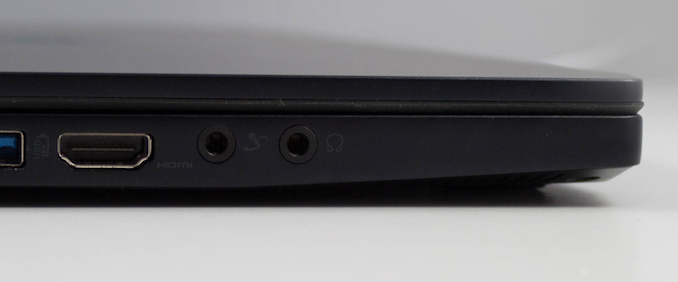
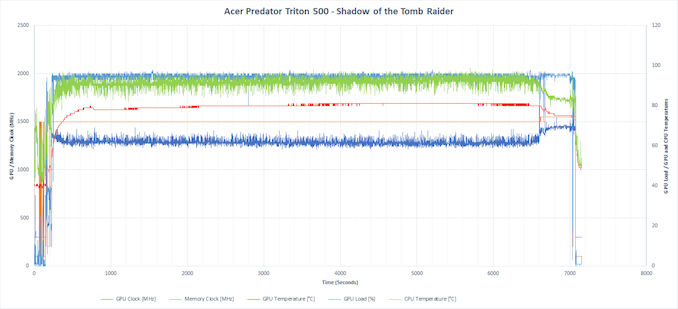


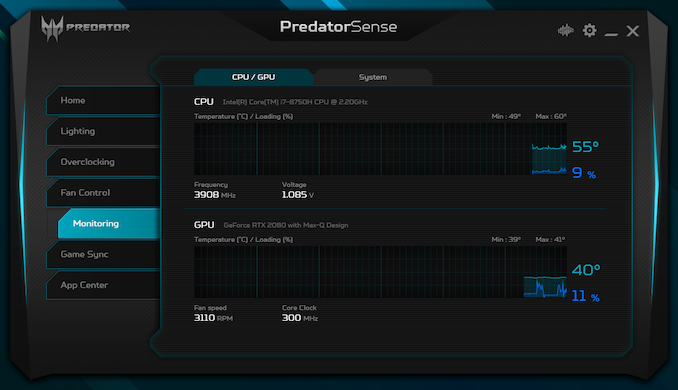

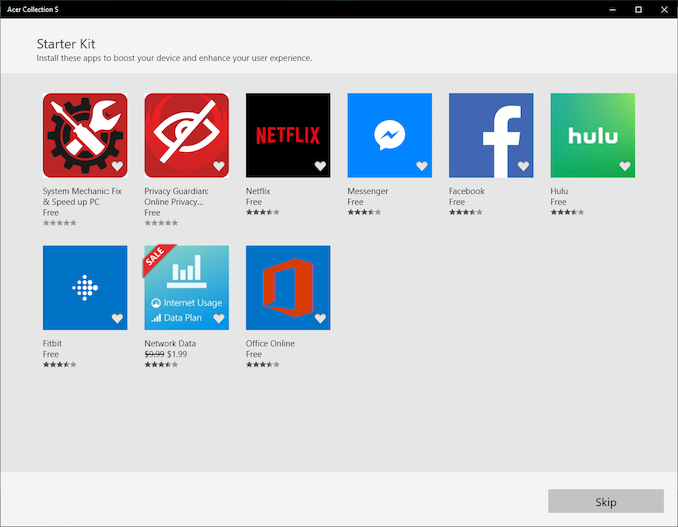








46 Comments
View All Comments
MrRuckus - Thursday, April 25, 2019 - link
This... Do yourself a favor and compare. 2080 Max-Q to standard 2080 you're looking at an average 30% drop in performance. No thanks. To me its a niche market that doesn't make a lot of sense. You want portability, but these are not meant to game on battery. They're meant to be plugged in all the time. Thinner and Thinner while trying to keep the performance (or the naming scheme of performance oriented parts) seems like an ever increasing losing battle. I personally wouldn't pay the premium 2080 price for a 30% hit in performance.DanNeely - Thursday, April 25, 2019 - link
Thin and light enough to pass as a normal laptop, while still able to game significantly better than on an IGP is a valid market segment; and at the x60 level is probably what I'll be getting for my next laptop in a year or two. OTOH for people who want something that's a normal laptop first and a gaming system second, I suspect Optimus (for battery life) over GSync is probably the better choice until/unless NVidia can integrate the two.Rookierookie - Thursday, April 25, 2019 - link
Yeah, I wish they had a version that offered a FHD panel with Optimus. No 4K, no GSync, and lasts at least 6 hours on battery surfing the web. The Gigabyte Aero is still more or less the only viable option for thin, light, powerful, and decent battery.The ConceptD 7 that comes out later this year looks really attractive, but it has a 4K panel so again I'm not optimistic about battery time.
Opencg - Thursday, April 25, 2019 - link
optimus is great with the exception of when they wire the igpu to the external ports. imo you should be able to plug into a vr headset or external gsync monitor. you might give up the ability to run a presentation on a projector in low power optimus mode but imo when you are pluging into external displays you are probably plugging into the wall anyway.Brett Howse - Thursday, April 25, 2019 - link
Apparently this laptop has a MUX to allow you to choose between G-SYNC and Optimus. I've updated the article and am re-running the battery life tests right now and will add them in when done. So really this is the best of both worlds.jordanclock - Thursday, April 25, 2019 - link
The biggest problem is that Max-Q can mean everything from specs that match the desktop down to half the TDP rating. So a 2080 Max-Q can be below a 2070 Max-Q depending on how each OEM configures the TDPs and clocks.Tams80 - Saturday, April 27, 2019 - link
You're clearly not the market for it.There is a significant market for one machine that is as best as possible for gaming when plugged in, but decent as an everyday machine when not. I'd say that market also value the machine being light for transporting between places.
You may poo poo such a use case, but it can be very tiresome maintaining more than one machine. People are willing to pay a premium for lower specs for that. Then there are those who just want the 'best' numbers in everything, but they'll buy anything.
Fallen Kell - Monday, April 29, 2019 - link
Except that he is the market. The complaint is that these companies are putting in features that they are marketing the device on which the device has no chance of being able to accomplish. This device isn't the best as possible for gaming when plugged in. It can't cool itself even when plugged in to have even a chance of using the 2080 GPU or even the CPU for more than a few seconds before thermal throttling. These shenanigans should ALWAYS be called out. If they want to make a thin laptop, then they should put in hardware that it can actually use at full capability without thermal or power throttling when plugged in. In this case, it would probably mean stepping down the CPU and GPU.
The marketing guys know that will affect sales because they can't say they have the top of line components, but the whole max-q that Nvidia released along with relying on Intel's thermal throttling is letting companies say they have all this hardware in a thin laptop and people are buying them thinking they have that hardware, not knowing they are buying something that is possibly running 30-40% slower than it should be and could have saved hundreds of dollars and had the exact same performance if they simply used the "slower" parts that worked in the thermal and power loads of the laptop in the first place.
plewis00 - Saturday, April 27, 2019 - link
Totally agree. If you want performance then expect a big machine to cart around. Making things thinner doesn't work all the time, Apple's MacBook range is a great example of how to ruin machines by making them obsessively thin.not_anton - Friday, April 26, 2019 - link
Apple did the same with Macbok pro 15, my Radeon 460 works at mere 960MHz with decent performance and ridiculously low power for a 1000-core GPU chip.The downside is the value for money that you'll get - about the same as Apple's :D